Yellow peppers are among the most popular types of peppers and they’re one of the most widely available. They are delicious and versatile alternative to red, green and orange peppers.
Yellow peppers may have earthy, sweet, fruity, floral or smoky flavors and the spice levels will vary dramatically between cultivars ranging from mild, moderate to scorching.
The yellow color of the peppers is due to the presence of pigment compounds called carotenoids, which are also found in other yellow and orange fruits and vegetables.
Yellow peppers are common ingredient in a variety of dishes including salads, stir-fries and grilled vegetables. They can also be baked into casseroles, used as toppings on pizza, tacos and pasta, grilled as smoky side dish or cooked into pepper jelly and sauces.
Depending on variety, they can too be dried and ground into a spice or pickled for extended use as a condiment.
Yellow peppers either grow like vines or bushes. Those that grow like bushes are usually smaller plants with a more compact growth habit. They produce fewer peppers but may mature faster than that grow like vines.
On the other hand, peppers that grow like vines are characterized by long, trailing stems that grow horizontally along the ground or on trellis. They produce more peppers than bush varieties and may take longer to mature.
Yellow Peppers can grow anywhere as frost-tender annuals during the warm months of the year, and they need a long growing season for good fruit production.
There are many varieties of yellow peppers each with a different shape, size, flavor and spice level. A brief look at their history, characteristics, use and the variety of options you have when choosing one or another will provide you with a good starting point.
List of Yellow Peppers
- Fatalii Pepper
- Aji amarillo Pepper
- Lemon Drop Pepper
- Banana Pepper
- Hungarian Wax Pepper
- Bell Pepper
- Yellow Peter Pepper
- Santa Fe grande peppers
- Golden Cayenne peppers
- Trinidad Perfume
- Chilly Chili
- Bolivian Rainbow Pepper
- Aji Charapita
- NuMex Twilight
- Prairie Fire Pepper
- Devil’s Tongue Pepper
- Madame Jeanette Pepper
- Sugar Rush Peach
What is a Scoville Heat Scale (SHU)?
Before going further, it is also important to talk about Scoville heat unit (SHU) which is an important concept when it comes to understanding different varieties of peppers. So, what is Scoville heat unit (SHU)?
The Scoville heat scale is used to measure the heat level of peppers and other spicy foods. It is based on the concentration of capsaicin, the compound that gives peppers their heat. It is named after Wilbur Scoville, an American pharmacist who developed a method for measuring the heat of peppers in 1912.
Capsaicin is measured in Scoville heat units (SHU). The higher the number of SHUs, the hotter the pepper is. Peppers with a high Scoville rating, like the Trinidad Perfume pepper, are generally considered to be quite spicy and may be too hot for some people.
Description
Fatalii Pepper

Fatalii peppers originated from Central America and are now grown in many parts of the world. These are believed to be closely related to the habanero, sharing similar shape, flavor and aroma.
The skin is deeply creased and folded with a semi-wrinkled appearance and is waxy, ripening from green to bright yellow when mature.
These peppers have a high level of spiciness, with a Scoville heat unit rating of around 125,000 to 350,000. They have a fruity and citrus-like flavor, in addition to their heat.
Fatalii peppers can be used in sauces, marinades, and spice blends, and are quite popular in Mexican and South American cuisines.
Fatalii pepper plants have a compact growth habit reachinv a height of around 2 to 3 feet. They produce small, white flowers that give way to the pepper fruits.
The plants prefer warm, sunny conditions and well-draining soil. They are sensitive to frost and should be planted after the danger of frost has passed in the spring.
The plants can be grown in containers or in the ground, and may benefit from staking or support to prevent the plants from collapsing under the weight of the peppers. The papers are available in the fall.
Also Read: Different Types of Yellow Apples
Aji amarillo Pepper
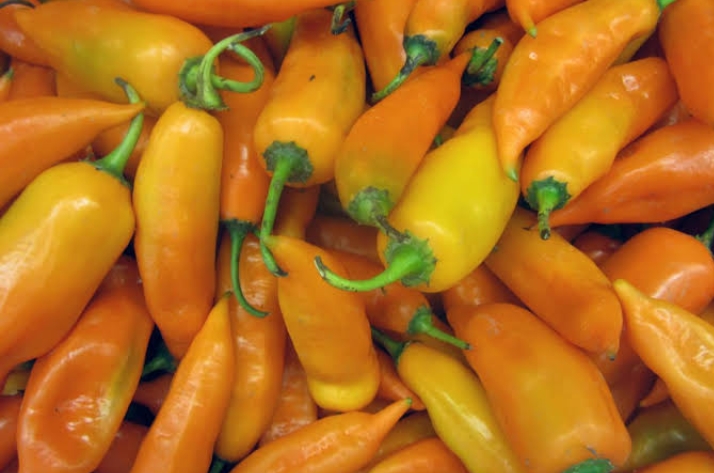
Aji amarillo also referred to as Aji Escabeche is native to Peru. The pepper has a medium level of heat, with a Scoville rating of 30,000-50,000 units. It has a fruity and mildly sweet flavor, with hints of tropical fruit and citrus.
Aji amarillo pepper plants are small to medium in size, about 2 to 3 inches long. When the peppers are young, they are often green in color and turn yellow as they mature.
Some varieties of aji amarillo peppers may also have a reddish or purple tinge to their skin, especially when they are fully ripe.
Aji amarillo is a staple ingredient in many traditional Peruvian cuisine, including lomo saltado, a stir-fry made with beef, onions, and tomatoes, and causa rellena, a dish made with mashed potatoes and filled with chicken or seafood.
It is also used in a variety of sauces and marinades, and is often served alongside dishes as a condiment.
Lemon Drop Pepper

The Lemon Drop pepper also referred to as Aji Limon or Aji Limo is native to South America specifically Peru. It is small in size, only about 2 to 3 inches long.
It has a thin, pointed shape that is similar to that of a jalapeno pepper, but this one is a bit smaller and slenderer. The skin is thin reminiscent of lemon skin and can range in color from yellow to orange, depending on the variety.
The lemon drop pepper is averagely hotter, with a Scoville heat scale rating of 30,000 to 50,000 units, which is a heat level similar to cayenne peppers. It is considered by many gardeners to be the best tasting peppers for hot sauce.
It can be used in cooking as a way to add a spicy, citrusy kick to dishes or as a garnish for cocktails and other drinks. Also, it can be diced and added to tomato sauce or other sauces to give them a spicy kick.
Unlike many other peppers that grow as annuals, lemon drop can grow as a perennial. The plant is high yielding in nature with one plant capable of producing over 100 fruits.
The fresh peppers will keep 1 to 2 weeks when loosely stored whole and unwashed in a plastic bag in the refrigerator. The plants can also be grown in pots or containers; and be placed on a sunny patio or balcony.
Banana Pepper

The banana pepper also referred to as the yellow wax pepper or banana chili small, is a sweet pepper that is native to South America. It is named for their curved, banana-like shape and are usually yellow or green in color. It is possible for the pepper fruit to change to green, red or orange as it ripen.
In most cases, the pepper itself is just about 2 to 3 inches in size, though the size can vary somewhat. The pepper is particularly not hot, with a Scoville heat scale rating of 0 to 500 units, which is comparatively five times milder than the average Jalapeno.
The banana pepper is sweet with tangy flavor that is enhanced at maturity. The peppers can be used in a variety of dishes, including salads, sandwiches, pizzas, and pickled as a garnish or snack.
It can also be sliced and added to dishes as a garnish to add flavor and color. In addition to fresh and pickled preparations, the pepper can be stuffed and fried or cooked into pepper jelly.
Banana pepper plants are prolific producers, growing 30 to 35 pods per plant. They can be grown in pots or containers and fits well in small spaces.
They can also be planted directly in the ground in a sunny location. They can too be grown in a greenhouse or other protected environment to help protect them from extreme weather conditions.
Hungarian Wax Pepper
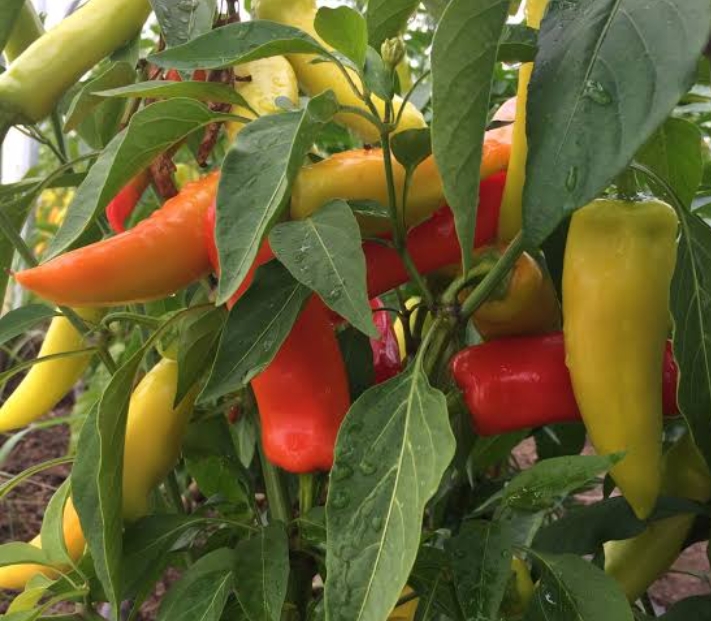
The Hungarian wax pepper is a medium-sized pepper closely related to the Banana peppers. It is native to Hungary where it was introduced by the Turks.
The skin is waxy and smooth, ripening from a pale green-yellow to orange, and then to red-orange depending on its stage of ripeness.
It is actually long and narrow, with a waxy texture and fruity flavor. It is a popular ingredient in many dishes, particularly in Hungarian and Central European cuisines.
The pepper has a Scoville heat unit rating of between 1,000 and 15,000, which is considered to be moderate to hot.
Hungarian hot peppers can be used fresh in salsas, dips, salads, pickled by themselves or in relishes, and as an ingredient in stews, soups and marinades. They can also be grilled.
The Hungarian wax pepper plant is a perennial in warm climates, but it can also be grown as an annual in cooler climates. The pepper plant is about 2 to 4 feet in size and produces a large number of peppers.
The peppers are available in the summer through early fall. The fresh peppers will keep 1 to 2 weeks when stored whole and unwashed in a plastic bag in the refrigerator.
Bell Pepper
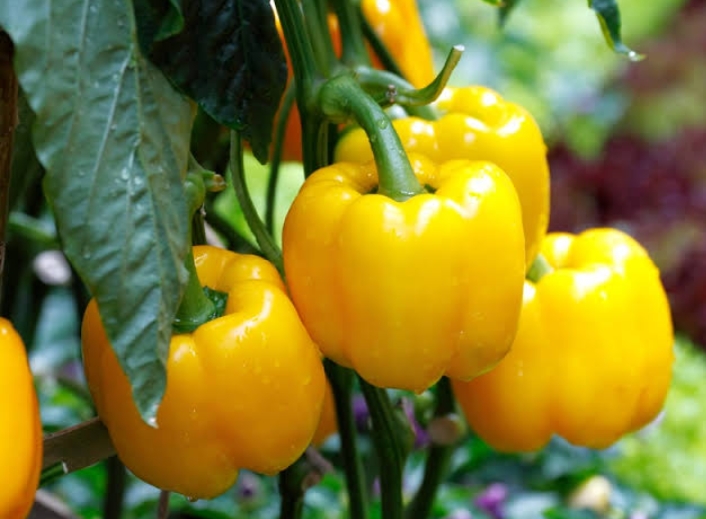
Bell peppers, also known as sweet peppers or capsicums are native to Central and South America, but are now grown all over the world.
The peppers can be green, red, yellow, orange, and purple in colour with each having its own unique flavor profile.
The skin is firm and glossy with a central, hollow cavity that contains very small, flat and bitter cream-colored seeds and a thin, spongy white to pale red membrane.
Bell peppers, including yellow bell peppers, do not contain capsaicin, the compound that gives hot peppers their spicy heat. As a result, they have a Scoville heat unit rating of 0 SHUs. This means that they are not spicy or hot, and have a mild flavour. They can be cooked and blended into marinara sauces, stews, chilis or soups.
Bell peppers grow during the warm summer months as annual vegetables and can begin fruiting in as few as 35 days after flowering. They require proper planting to ensure good growth, whether you grow them from seed or seedlings.
They are easy to grow and produce a large harvest. Bell peppers are ready to be harvested when they are fully ripe and have reached their mature size and color.
Peter peppers

Peter peppers are believed to be native to the southern United States, especially to Texas and Louisiana, and have been documented since the 1700s.
The peppers are primarily considered to be an ornamental variety. There are three main varieties: orange, red to yellow. They are moderately hot, with a Scoville heat unit rating ranging 5,000-30,000 units.
The peppers have irregularly shaped pods with wrinkled, cylindrical shape ending with a rounded, blunt tip accented with a cleft. They have a mild flavor and crisp, crunchy texture.
The Peter Pepper is most common in Mexican and Southwestern cuisine, where it is used to add flavor and heat to dishes such as salsa, guacamole, and chili.
It is also sometimes used as a garnish or decorative element in dishes due to its unique appearance.
Santa Fe Grande
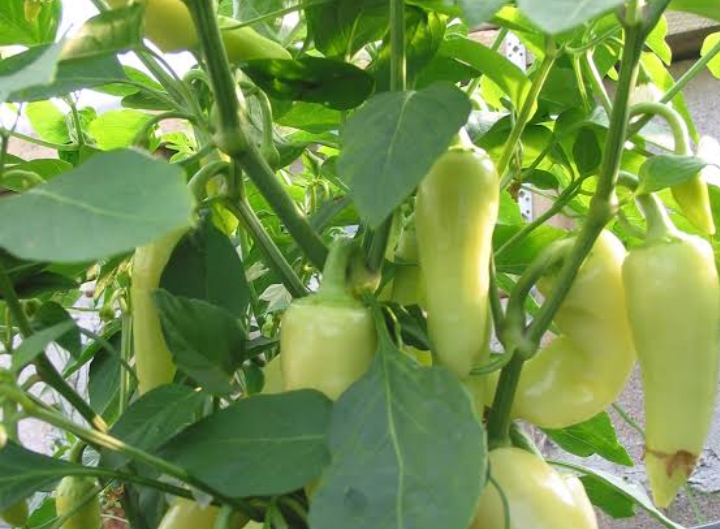
Santa Fe Grande peppers are native to the southwestern United States and Mexico. They are genera, are conical in shape and taper to a point at the end.
In terms of color, Santa Fe Grande peppers start off green and then turn yellow as they mature. These peppers have a heat level of about 1,000 to 2,500 Scoville heat units, which is considered to be on the lower end of the heat scale for chili peppers.
They too have a mild flavor and can be good for those who prefer milder level of spiciness in their food.
Santa Fe Grande pepper plants grow to be about 12 to 24 inches tall and have elongated leaves that are dark green color. The peppers themselves grow on the plants in clusters and are often ready to be harvested when they turn bright yellow in color.
When planted and provided with good care, these peppers will be available year-round, with a peak season in mid-summer. The peppers will keep up to one week when stored whole, unwashed, and loosely placed in a plastic bag in the refrigerator.
Golden Cayenne peppers

Golden cayenne peppers are thin and elongated, with a bright golden yellow color and a spicy, pungent flavor. They are named after the city of Cayenne in French Guiana, where they were originally cultivated. They are currently cultivated in very many places around the world including United States and Canada.
This pepper is quite hot, with a Scoville heat rating of 30,000-50,000 units, which is similar to other cayenne pepper varieties. They can add heat and flavor to very many types of dishes, including soups, stews, sauces and marinades.
Like the red cayenne, Golden cayenne peppers are dried and ground into a powder as added flavoring and heat.
In very many places such as united states and in colder climates, cayenne plants are grown as annuals and as perennials in warmer regions.
The plants produce small, white flowers that eventually give way to the peppers. It takes between three and four months for the peppers to mature and turn golden yellow.
The exact shade of yellow can vary somewhat based on factors such as the specific cultivar of pepper, the growing condition and the location where the peppers are grown.
Other than using the peppers in food preparations, cayenne pepper plants are sometimes grown for their attractive foliage. Which is glossy and bright green.
Trinidad Perfume peppers
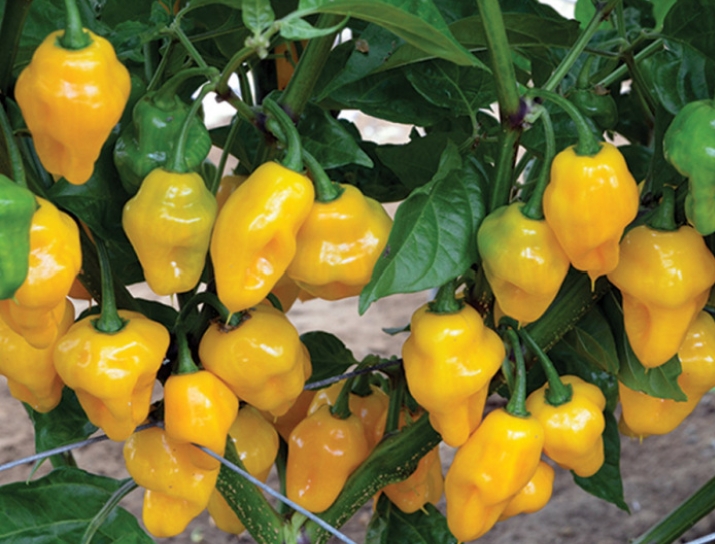
Trinidad Perfume peppers are native to Trinidad and Tobago. They are elongated and about 3 inches in size with a tapered, pointed shape.
The peppers are green when they are young, but they turn yellow as they mature. The heat level for these peppers is usually in the range of 100,000 to 350,000 Scoville heat units and this makes them quite hot when compared to other peppers.
When fully ripe, Trinidad Perfume peppers have fruity and floral aroma with somehow spicy flavor, which is similar to that of a habanero pepper.
In North America, they are used to add heat and flavor to various food preparations. They are often added to soups, stews, sauces, marinades, salsas, and other dishes to give them a spicy kick. In other places they are grilled or used as a topping for sandwiches and burgers.
Chilly Chili (F1)

Chilly Chili peppers are ornamental hybrid (F1) variety with pods that are small and elongated in shape. The skin may be smooth, glossy, transitioning through shades of green, ivory, yellow, orange, and then red at maturity.
They have a Scoville heat unit rating of between 1,000 and 5,000, and therefore they can be used for various culinary applications, including roasting, grilling, and pickling. They can be dried and ground into a powder for use as a seasoning.
When grown in optimal conditions, Chilly Chili pepper plants can produce a good yield of peppers over the course of the growing season.
In general, the peppers will begin to ripen and turn red in color after about 60 to 90 days from transplanting. Chilly chili pepper plants are more reliable and have more consistent performance. They too have increased disease resistance and other desirable traits.
The Bolivian Rainbow chili pepper

The Bolivian Rainbow chili pepper is native to Bolivia. It is characterized by bright, colorful appearance, with pods that range in color from green to yellow, orange, red and purple.
These peppers are small, growing between 2 and 3 inches long. They have glossy skin and a pointed tip at one end.
The Bolivian Rainbow chili pepper are not commercially produced and are grown on a small scale through home gardens. They are favored for their rapid growth, high yields and unique flavor.
When it comes to flavor, the Bolivian Rainbow chili pepper is quite hot, with a Scoville rating of around 30,000 to 50,000 units. The heat is similar to that of Tobasco and cayenne peppers but otherwise tastes similar to a bell pepper only with heat.
They have a sweet and fruity flavor, with a bit of heat and a slight bitterness. In places like North America, Asia and Europe they are often used fresh or dried in a number of cuisines, including soups, stews, sauces and marinades, and are also sometimes used medicinally for their potential health benefits.
Aji Charapita peppers
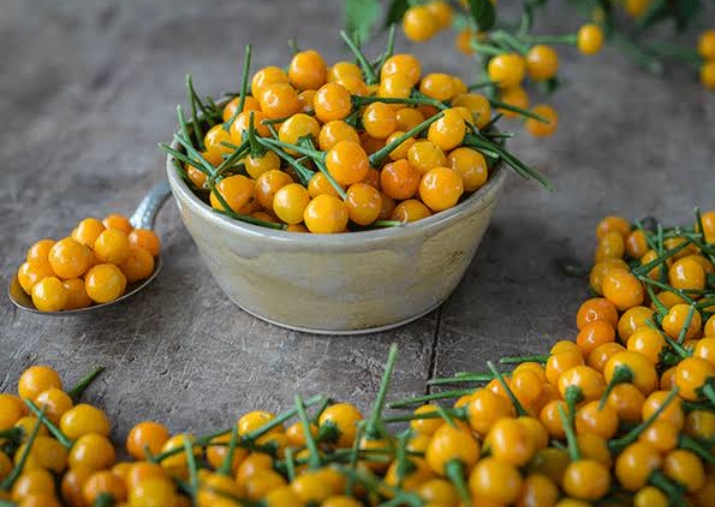
Aji Charapita peppers are native to the northern Peruvian jungles in a city named Iquitos. They are very small and have a round shape with a slender, straight green stem protruding from the pod.
The skin is green when young but changes to yellow when mature. These peppers in general have a bright, fruity taste with unique citrus flavors that are followed by a moderate to hot level of spice that gradually builds in intensity. Their heat level ranges between 30,000-50,000 units SHU on the Scoville scale.
Aji charapita peppers can be used in many dishes including salsas, sauces, marinades and condiments, or they can be diced and added to dishes such as stews, soups and stir-fries. They can too add heat and flavor to grilled meats and vegetables.
Devil’s Tongue pepper
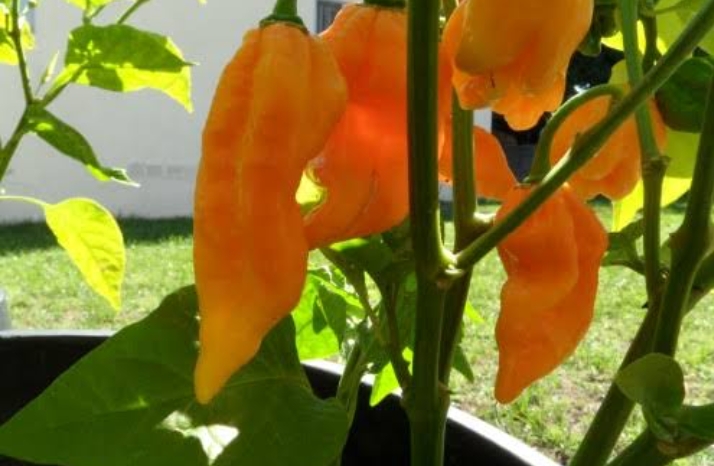
The Devil’s Tongue pepper is native to the Caribbean and Central and South America. It is a medium-hot pepper similar to habanero and the Scotch bonnet. The Devil’s Tongue pepper has a cylindrical shape that tapers to a point on the non-stem end.
The skin is glossy and may appear lightly wrinkled or creased and ripens from light green to golden yellow.
It can be used to add spiky kick to sauces, marinades rubs and other dishes. Some people also use it to make hot sauce or to add heat to cocktails.
The heat level of the Devil’s Tongue pepper can vary, but it is generally considered to be medium to hot, with a rating of 30,000 to 70,000 Scoville heat units.
Madame Jeanette Pepper
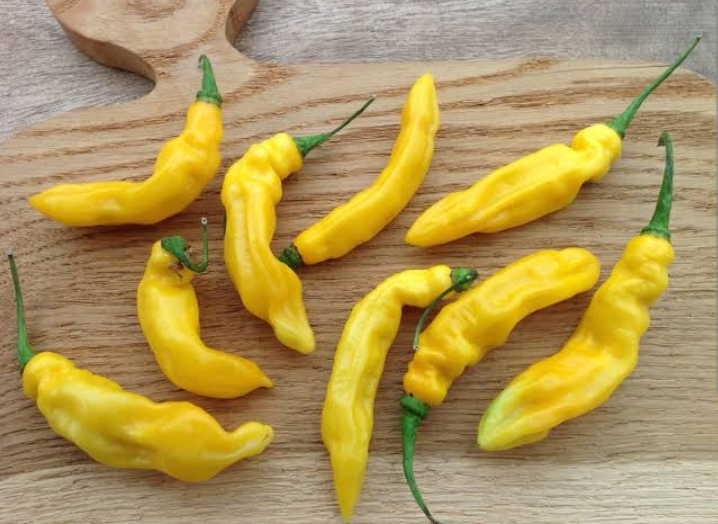
Madame Jeanette peppers are native to Suriname, South America. Also known as Suriname Yellow pepper, it has a smooth skin with few creases and folds, and the pods ripen from green to yellow or red-orange, on the account of variety and stage of maturity.
Madame Jeanette peppers are crunchy, aromatic, and intensely spicy with subtle fruity notes of mango or pineapple. It is a very hot pepper, with a Scoville heat unit rating of 100,000 to 350,000, making it one among the hottest peppers in the world.
The heat of these pepper has been described by many people as being sharp and intense, and some have even said that it can particularly be potent when eaten raw.
When cooked, the heat of the pepper tends to mellow out somewhat, and the fruity flavor becomes more pronounced. Just like other hot peppers, it can be used in sauces, spice blends, and other condiments.
Also Read: Celebrity Tomato
Sugar Rush Peach Pepper
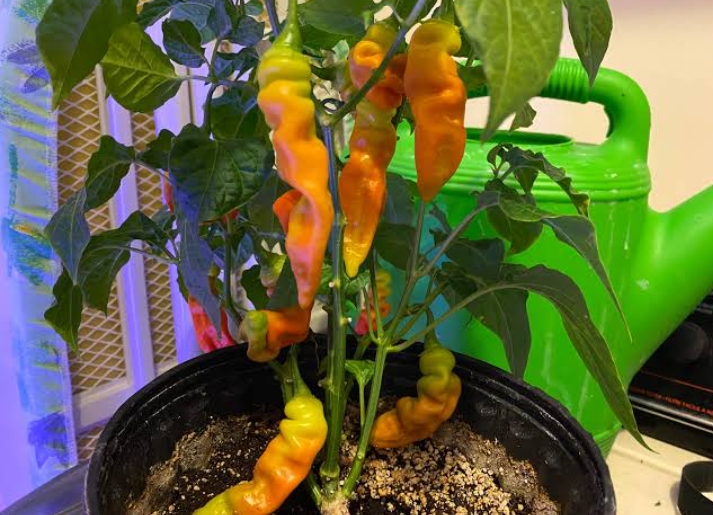
Sugar Rush Peach pepper was discovered in 2012 as an open pollination of South American sugar rush red chile peppers in the garden of Chris Fowler, chile pepper breeder, in Wales, Great Britain.
The peppers have elongated pods, with a cylindrical shape that tapers to a point on the non-stem end. The skin is smooth and may appear lightly wrinkled or creased and ripens from light green, golden yellow, to dark peach when mature.
Sugar Rush Peach chile peppers have sweet flavor with somewhat tangy taste that is similar to that of bell pepper, but with a bit of heat added.
The heat level of these peppers can vary, but to those who have tasted them so far, consider them to be medium-hot, even some people find them to be having little tropical flavor with hints of mango or peach.
Other than being used to add heat add flavor to foods, they can also be pickled or preserved in vinegar to be used as a condiment.